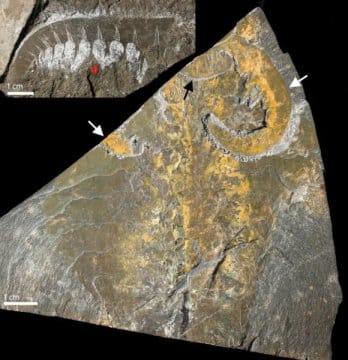The most comprehensive analysis of Earth's largest group of animals - arthropods - shows that they evolved gradually, challenging the mainstream theory that the first animals appeared almost all at once 540 million years ago
Soft tissue fossils of a predator from the Cambrian era, belonging to the arthropod family. Top left: A bump on the front of the modified creature shows a resemblance to modern arthropods. Bottom right: A full-body specimen of the fossil shows one pair of forelimbs (indicated by white arrows) and a mouth containing teeth (indicated by a black arrow) on the head. Photography: A. Daly, University of Oxford

All the major groups of animals began to appear in the fossil record 540-500 million years ago - an event known as " The Cambrian Bang " - but a new study by researchers from Oxford and Lausanne universities claims that for most animals - this "explosion" was actually a more gradual process.
The Cambrian explosion created the largest and most diverse group of animals - the arthropods, which includes the insects, crabs, spiders, trilobites, and a huge variety of other animal species, most of which have already become extinct. This system is over 80% of all animal species on Earth and they are a central component of all Earth's ecosystems, making them the most important group since animals first appeared over 500 million years ago.
A team of researchers from the Natural History Museum at the University of Oxford and their colleagues from the University of Lausanne have carried out the most comprehensive analysis ever made of fossil arthropods. In an article published in the scientific journal PNAS, they show that the total fossil record shows a gradual increase in several arthropod species during the Early Cambrian, that is, 540-500 million years ago.
The findings of the new analysis pose a challenge to the two main competing hypotheses about the early evolution of animals. One speaks of a slow and gradual development of the arthropods starting 650-600 million years ago, which also emerges from molecular dating methods. The second hypothesis claims that arthropods appeared almost immediately 540 million years ago and developed rapidly thanks to the high rate of evolution.
The new study offers a compromise in the middle, with the arthropods originating 550 million years ago, according to the newer estimates of molecular dating methods, and according to the diversification that will occur over the next 40 million years.
"Each fossil dating method has a limitation, and it varies from method to method, but when both are measured together, they make it possible to obtain a consistent picture of the origin of the arthropod eruption during the Early and Middle Cambrian," explains Professor Alison Daly, who carried out the work at the Museum of History of the University of Oxford and the University of Lausanne. "This indicates that the Cambrian explosion, instead of being a sudden event, unfolded gradually over the 40 million years of the Early and Middle Cambrian."
The timing of the origin of arthropods is very important because it affects the way we see and interpret the evolution of the group. This way we can follow the development of physical features, such as organs. Until now, the prevailing claim was that the lack of arthropod fossils from the Precambrian period, about 540 million years ago, was due to a lack of fossil preservation, but the new research shows that this is not the case.
"The idea that the absence of arthropods in the Precambrian era is due to gaps in fossil preservation can now be rejected," says Dr. Greg Edgecombe of the Natural History Museum in London, who was not involved in the study. "The authors make a convincing argument that the Late Precambrian and Early Cambrian are very similar in terms of fossil preservation, and there is only one plausible explanation: Arthropods have not yet evolved."
Harriet Drage, a PhD student in the Department of Zoology at the University of Oxford and one of the authors of the paper, says: "When it comes to understanding the early history of life, the best source of evidence we have is the comprehensive fossil record showing that arthropods originated in the early Middle Cambrian. They testify strongly to the origin of arthropods during a time when the fossil record is the best it has ever been."
